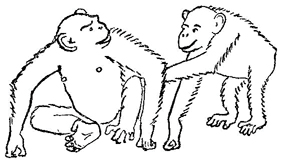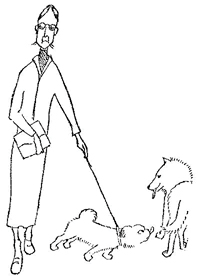

Pity—best taught by fellowship of woe.
Coleridge
If one listens to the remarks of the visitors in any of the larger zoos one will frequently find that people are in the habit of wasting sentimental pity on animals that are absolutely contented with their lot, while the genuine suffering which is to be found in every zoological gardens may pass unnoticed. People are specially apt to pity those animals which, owing to their particular emotional associations, play a prominent role in literature, like the nightingale, the lion or the eagle.
How much the real character of the singing nightingale is generally misunderstood is shown by the fact that, in literature, the bird is always represented as a female; in the German language the very word nightingale is of female gender. It is, of course, the male that sings and the meaning of the song is a defensive threat to all other males that might invade the songster’s territory, as well as an invitation to any passing female to join him. To anybody really familiar with birds, the masculinity of the singing nightingale is so blatantly apparent that to attribute loud song to a female bird is as comically incongruous as it would be to the student of literature had Tennyson invested Guinevere with a beard. For this reason I was never able to appreciate Oscar Wilde’s beautiful fairy tale of the nightingale who made the red rose “of music by moonlight” and “stained it with her own heart’s blood” and I must confess that I was heartily relieved when at last, with the thorn in her heart, the virago ceased her lusty singing.
Later on I shall deal with the supposed suffering of caged birds. Of course, the singly kept male nightingale may suffer some sort of disappointment when despite his prolonged singing no female puts in an appearance, but, owing to the excess of males, this is also liable to happen in nature.
The lion is another animal very often misrepresented in literature, both as to habitat and to character. The English call him King of the jungle—thus relegating him to much too wet a locality, while the Germans, with customary thoroughness, go to the other climatic extreme and deposit him in the desert, calling him “Wüstenkönig” (Desert King). In reality, he prefers the happy medium and lives in steppes or savannahs. His majesty of bearing, to which he owes the first part of his title, is due to the simple fact that, being a hunter of large animals of the open plains, he habitually surveys the far distance and disregards everything moving in the foreground.
The lion suffers less under close confinement than most other carnivores of equal mental development, for the simple reason that he has a lesser urge for movement. To put it crudely, the lion is about the laziest of the predatory beasts: he is indeed quite enviably indolent. Under natural conditions he covers enormous distances, but obviously only under pressure of hunger and not from any inward drive. Therefore, it is seldom that a lion in captivity is seen pacing restlessly to and fro in his cage as wolves and foxes will do for hours at a stretch. If the pent-up drive for locomotion urges him, for once, to walk up and down the length of his cage, his movements bear the character of a leisurely after-dinner stroll and have nothing of the frantic haste with which captive canine carnivores discharge their frustrated urge to cover large distances. In the Berlin Zoo, a huge paddock with desert sand and yellow rocky crags was made for the lions, but this expensive construction proved very nearly useless; a gigantic model with stuffed beasts might have served the same purpose, so lazily did the lions lie about in their romantic surroundings.
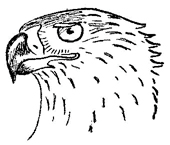
And now for the eagle! I hate to shatter the fabulous illusions about this glorious bird, but I must adhere to the truth: all true birds of prey are, compared with passerines or parrots, extremely stupid creatures. This applies particularly to the golden eagle, “the eagle” of our mountains and our poets, which is one of the most stupid among them, much more so indeed than any barnyard fowl. This, of course, does not preclude this proud bird from being beautiful and impressive and embodying the very essence of wild life; but here we have to deal with the mental qualities of the creature, its supposed love of freedom and its imaginary suffering in captivity.
I still remember what disappointment was caused me by my first and only eagle, an imperial eagle which I bought, out of pity, from a wandering menagerie. She was a beautiful female bird, nearly matured in colour, a sign that she boasted several years. She was completely tame and greeted her keeper, and later myself, with a curious gesture of affection in which she turned her head upside down, so that the fearful curve of her beak pointed perpendicularly upwards. At the same time, the creature spoke in tones so quiet and docile as to be worthy of a turtle dove; moreover, compared with the latter, she was a veritable lamb (see Chapter 12). I originally bought her because I intended to train her for hawking, as many Asiatic peoples are known to do with eagles. I did not flatter myself that I should acquire any particular success in this noble sport, but I hoped, if only by using a domestic rabbit as bait, to make observations on the hunting behaviour of one of these large birds of prey. This plan failed because my eagle, even when she was hungry, refused to harm a hair of the rabbit’s body.
She also showed little inclination for flight although she was healthy and strong and possessed excellent wing feathers. Ravens, cockatoos and buzzards fly for the pleasure of it, and playfully enjoy the fullness of their ability. But not so this eagle. She only flew at all when there were favourable up-currents over our garden which enabled her to soar without expending much muscle power, and, even then, she never circled really high. When she wished to come down, she invariably failed to find her way home. She circled around without any sense of direction and landed at last somewhere in the neighbourhood. There she sat unhappy and benighted and waited till I fetched her. Perhaps she might have come home alone, but she was so conspicuous that somebody always telephoned from somewhere that the eagle was sitting on this or that roof where a crowd of small boys was pelting her with stones. Then I had to go there on foot, because the silly creature was desperately afraid of a bicycle. Again and again have I plodded, in this manner, wearily home, the eagle on my arm. In the end, because I did not wish to keep her permanently chained up, I gave her to the Schönbrunn Zoo.
The large aviaries that are to be found to-day in every good zoo allow adequately for the flying inclinations of an eagle, and could one interrogate one of these birds I think it would submit the following information on the subject of its wishes or complaints: “We suffer here mostly from over-population of our enclosure. As often as I or my wife add a twig to our half finished nest, one of these vile white-headed vultures comes and carries it away. The company of the American bald-headed eagles also gets on my nerves; they are stronger than we are and horribly overbearing. And still worse is the Andean condor, that disagreeable fellow. The food is quite good, but we get a bit too much horseflesh; I should far prefer smaller animals, for example rabbits, including their fur and bones.” The eagle would not speak of a longing for golden liberty.
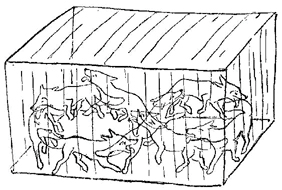
Now which are the animals really to be pitied in captivity? I have already given a partial answer to this question: In the first place, those clever and highly developed beings whose lively mentality and urge for activity can find no outlet behind the bars of the cage. Furthermore, all those animals which are ruled by strong drives that cannot be satisfied in captivity. This is most conspicuous, even for the uninitiated, in the case of animals which, when living in a free state, are accustomed to roam about widely and therefore have a correspondingly strong drive for locomotion. Owing to this frustrated desire, foxes and wolves housed, in many old-fashioned zoos, in cages which are far too small, are among the most pitiable of all caged animals.
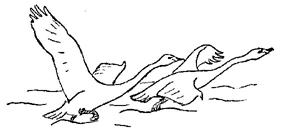
Another piteous scene, seldom noticed by ordinary zoo visitors, is enacted by some species of swans at migration time. These creatures, like most other water fowl, are in zoos generally rendered incapable of flight by the operation of “pinioning”, that is the amputation of the wing bone at the metacarpal joint. The birds never really grasp that they can fly no more and they try again and again. I do not like pinioned water birds; the missing tip of one wing and the still sadder picture that the bird makes when it spreads its wings spoil most of my pleasure in it, even if it belongs to one of those species which do not suffer mentally by the mutilation.
Though pinioned swans generally seem happy and signify their contentment, under proper care, by hatching and rearing their young without any trouble, at migration time things become different: the swans repeatedly swim to the lee side of the pond, in order to have the whole extent of its surface at their disposal when trying to take off against the wind. All the while, their sonorous flying calls can be heard as they try to rise, and again and again the grand preparations end in a pathetic flutter of the one and a half wings; a truly sorry picture!
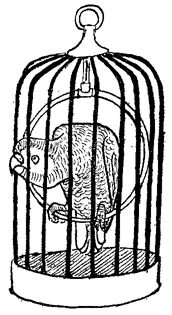
But of all animals that suffer under the inefficient methods of many zoological gardens, by far the most unfortunate are those mentally alert creatures of whom we have spoken above. These, however, rarely awaken the pity of the zoo visitor, least of all when such an originally highly intelligent animal has deteriorated, under the influence of close confinement, into a crazy idiot, a very caricature of its former self. I have never heard an exclamation of sympathy from the onlookers in the parrot house. Sentimental old ladies, the fanatical sponsors of the societies for prevention of cruelty to animals, have no compunction in keeping a grey parrot or cockatoo in a relatively small cage or even chained to a perch. Now these larger species of the parrot tribe are not only clever but mentally and bodily uncommonly vivacious; and, together with the large corvines, they are probably the only birds which can suffer from that state of mind, common to human prisoners, called boredom. But nobody pities these pathetic creatures in their bell-shaped cages of martyrdom. Uncomprehendingly, the fond owner imagines that the bird is bowing, when it constantly repeats the bobbing head movements which, in reality, are the stereotyped remnants of its desperate attempts to escape from its cage. Free such an unhappy prisoner, and it will take weeks, even months, before it really dares to fly.
More wretched still in confinement are monkeys, above all the anthropoid apes. They are the only captive animals which can derive serious bodily harm from their mental suffering. Anthropoid apes can become literally bored to death, particularly when they are kept alone in too small cages. For this and no other reason, it is easily explained why monkey babies thrive admirably in private ownership where they “live as the family”, but that they immediately begin to pine when, having become too large and dangerous, they are transferred to the cages of the nearest zoo. My capuchin monkey Gloria was overtaken by this fate. It is no exaggeration when I say that real success in the keeping of anthropoid apes was only achieved when it was realized how to prevent the mental sufferings caused by confinement. I have beside me the wonderful chimpanzee book by Robert Yerkes, one of the best authorities on this kind of ape; from this work it may be concluded that mental hygiene plays just as important a role as physical, in the maintenance of health of these most human of all animals. On the other hand, to keep anthropoid apes in solitary confinement and in such small cages as are still to be found in many zoos, is an act of cruelty which should be punishable by law.
In his big anthropoid ape station in Orange Park, Florida, Yerkes has kept, for many years, a chimpanzee colony, which has multiplied freely and in which the apes live as happily as do my lesser whitethroats in their aviary, and much more happily than you or I.
